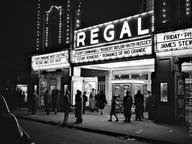Quiz Answer Key and Fun Facts
1. According to "The Celluloid Closet", what was the first gay stock character, often used for comic relief, to become widespread?
2. "The Celluloid Closet" showed clips from movies in the 1930s in which major actresses cross-dressed. One was "Queen Christina" (1933) starring Greta Garbo. What was the other one, which starred Marlene Dietrich in an exotic setting?
3. According to "The Celluloid Closet", once the Hays Production Code was adopted in the 1930s, gays and lesbians were not erased from Hollywood cinema but harder to find. A new identity was created, the cold-blooded villain, although the villain's homosexuality was "coded" rather than explicit. Which film noir piece starring Humphrey Bogart does the documentary use as an example of this?
4. "Leave it to Alfred Hitchcock to create not one but two gay villains" remarks one of the film historians interviewed in "The Celluloid Closet", a documentary about homosexuality in Hollywood cinema. Which Hitchcock film features two boys who murdered just to know what it felt like?
5. "You know, there are only two things more beautiful than a good gun: a Swiss watch or a woman from anywhere. Ever had a good Swiss watch?"
"The Celluloid Closet" (1995) explores several instances of coded homosexuality. From which movie was the above dialogue uttered as two cowboys admiringly exchange each others' guns?
6. In the documentary "The Celluloid Closet", writer Gore Vidal claims that in one movie starring Charlton Heston, he told the co-star, Stephen Boyd, to play his role as though the two men had been former lovers. (Heston was not informed.) Which blockbuster could this possibly be?
7. "The Celluloid Closet" contends that even under the restrictive Motion Picture Production Code, enforced by the Hays Office of the Motion Picture Association of America, Hollywood in the mid-twentieth century was freer to portray lesbians than gay men, "as long as they remained safely behind bars". What does the documentary select as the epitome of the women-in-prison genre in this period?
8. "The Celluloid Closet" (1995) shows clips from a comedy in which the leading men, Tony Curtis and Jack Lemmon, dress up as women and join an all-girl band to evade angry mobsters. Which movie features this sustained cross-dressing?
9. From the 1940s through the 1960s, as Lily Tomlin informs us in "The Celluloid Closet", a pattern emerged: "Characters with questionable sexuality would meet with a nasty end in the last reel." Which film is not matched correctly with its gruesome fate for such characters?
10. Beginning in the 1970s, depictions of gays and lesbians changed. Several films appeared in which the homosexual or transgender character(s) did not die in the last reel! Three of these are examples cited in the documentary "The Celluloid Closet"; which is the odd one out?
11. In the "Celluloid Closet" the narrator observes, "the downside of the new gay visibility was the threat of retaliation." Numerous films of the 1970s and '80s depicted brutality against gay men, and brutality *by* gay men. Which film starring Al Pacino do interviewees in the 1995 documentary "The Celluloid Closet" associate with the promotion of gay-bashing?
12. "One movie was so bold," narrates Lily Tomlin, "as to depict [male] homosexuality as an act of love, not violence, so Hollywood had to warn the public." Among the first since the silent era to "[deal] openly and candidly with a delicate issue," as the disclaimer read, "Making Love" starred Michael Ontkean, Kate Jackson, and what handsome star from "Clash of the Titans" (1981)?
13. "The Celluloid Closet" (1995) points out that homoerotic scenes and elements in movies about women did not receive the same kind of antagonism as in movies about men. The documentary gives three of these movies as examples of this reaction (or lack of reaction); which does not belong?
14. "The Celluloid Closet" (1995) ends with a montage of films that it describes as part of a "new gay sensibility," particularly among independent films, that depicted members of the LGBT community in a more sympathetic and complex light. Which was NOT among the films in this montage?
15. The 1995 documentary film "The Celluloid Closet" was based on a book of the same name. To what late film historian, the author of this book, was the movie dedicated?
Source: Author
gracious1
This quiz was reviewed by FunTrivia editor
jmorrow before going online.
Any errors found in FunTrivia content are routinely corrected through our feedback system.
